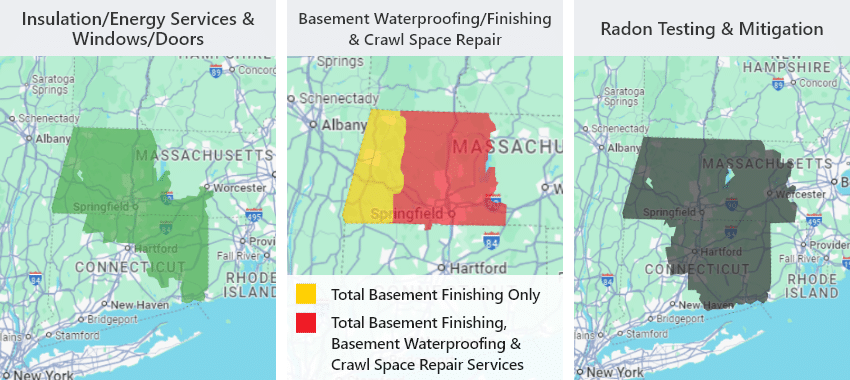Air Loss from the Rim Joist and Wood Framed Wall
The fundamental principle that drives energy loss in a home is called “stack effect”; air heats up and rises in the home, creating a high pressure area, and escapes out through penetrations at the top. As air leaves through the top of the house, suction is created in the lower part of the house, which pulls in an equal amount of air to replace the air that has been lost. The leakier a house is, the more it will cost the homeowner to heat and cool the new air that replaces the lost conditioned air.
The way that the stack effect is controlled is through air sealing efforts. It is most important to prevent the air from leaving the house; this is achieved by targeted foaming and construction of specific barriers in the attic. The attic air sealing efforts have been approved for the apartments at Ely Place and Canal Place, however, the desired result will not be complete unless the top and bottom of the buildings are properly sealed.
Air movement is fueled by pressure differences, and air naturally creates equal and opposite forces based on those pressures. As was previously stated, the hot, buoyant air at the top of the home creates a high pressure area, therefore, the equal and opposite pressure will be in the area as far away from the top of the home as can be – the bottom, i.e. the basement. Because of the large pressure difference between inside and outside the home at the basement level, air sealing at the basement level becomes just as high of a priority as the attic. To further illustrate this point, if the top of the home has high pressure (in relation to outside), and the bottom of the home has low pressure (in relation to outside) somewhere between the top and bottom will be a middle point where the air pressure is the same as outside; this is called the neutral pressure plane. If air moves because of differences in air pressure, and there is no difference in pressure in the middle of the house as to compared to outside, then sealing that area will not have the same beneficial effect as sealing the top and bottom of the building.
The specific scope of work at Ely Place and Canal Place involves two areas of construction; the rim joist and the wood framed walls of the walk-out basements. The rim joist is the area of construction where the building transitions from a concrete foundation to a wood wall. At this point, there are horizontal sill plates, a vertical rim joist that rests on those plates, and floor joists that are hung to the rim joist. Because of the rough nature of construction materials, none of these connections will be perfectly joined, and therefore, not airtight. The rim joist is the leakiest part of any building, purposeful large openings notwithstanding. When a framed wall exists in the basement, the same conditions apply, because the walls have not been completely finished. Dry wall creates an effective air barrier for the home in the finished space, but when it has not been properly applied in a basement, the exposed construction conditions create an easy air passage to accommodate the large pressure difference.
The secondary improvement of these two construction techniques comes in the form of insulation. By air sealing with materials that also have a high R-value, or resistance to thermal transfer, the need for heating or cooling in a home is further reduced, which reduces the cost of operation, and the condition of the home is improved as well. The primary principle behind the inclusion of insulation is that an effectively weatherized home aligns its air pressure boundary with its thermal boundary; basically, heat transfer and air transfer should stop at the same place. When there is a gap between the two, the moving air has a negative effect on the performance of the insulation.
As far as the house and its boundaries are concerned, a space is either inside or outside; if the insulation is in the floor between the basement and the first floor, then the basement is outside. This is not a suggested design because of the presence of mechanical equipment and appliances in the basement. If the basement is outside, then the problem of frozen water pipes is introduced to the structure. This may occur in washing machines, water heaters or water supply lines which are all located in the basements of these units. Also, the heat that is emitted by the mechanical equipment is prevented from entering the conditioned space above, and lost out of the foundation walls. With insulated foundation walls, this heat load is held in the conditioned space, preventing the freezing of water pipes and providing a partial heating load to the benefit of the rooms above.
our service area
We serve the following areas
- Adams
- Ashley Falls
- Becket
- Berkshire
- Blandford
- Cheshire
- Chester
- Cummington
- Dalton
- Drury
- East Otis
- Glendale
- Granville
- Great Barrington
- Hinsdale
- Housatonic
- Lanesborough
- Lee
- Lenox
- Lenox Dale
- Middlefield
- Mill River
- Monroe Bridge
- Monterey
- North Adams
- North Egremont
- Otis
- Pittsfield
- Plainfield
- Richmond
- Rowe
- Sandisfield
- Savoy
- Sheffield
- South Egremont
- South Lee
- Southfield
- Stockbridge
- Tyringham
- West Stockbridge
- Williamstown
- Windsor
- Worthington
- Barkhamsted
- Burlington
- Colebrook
- North Canton
- Riverton
- West Hartland
- Winsted


